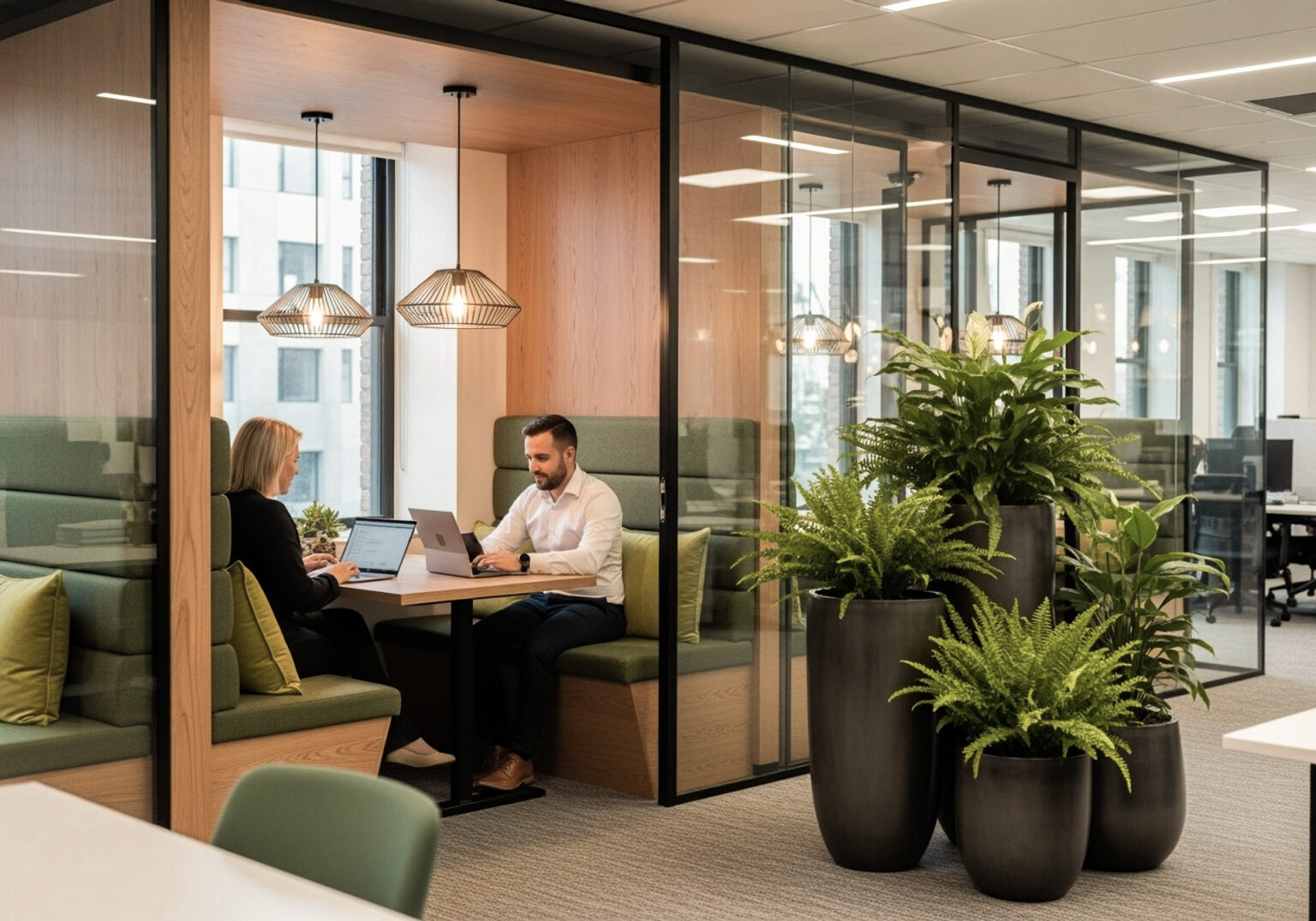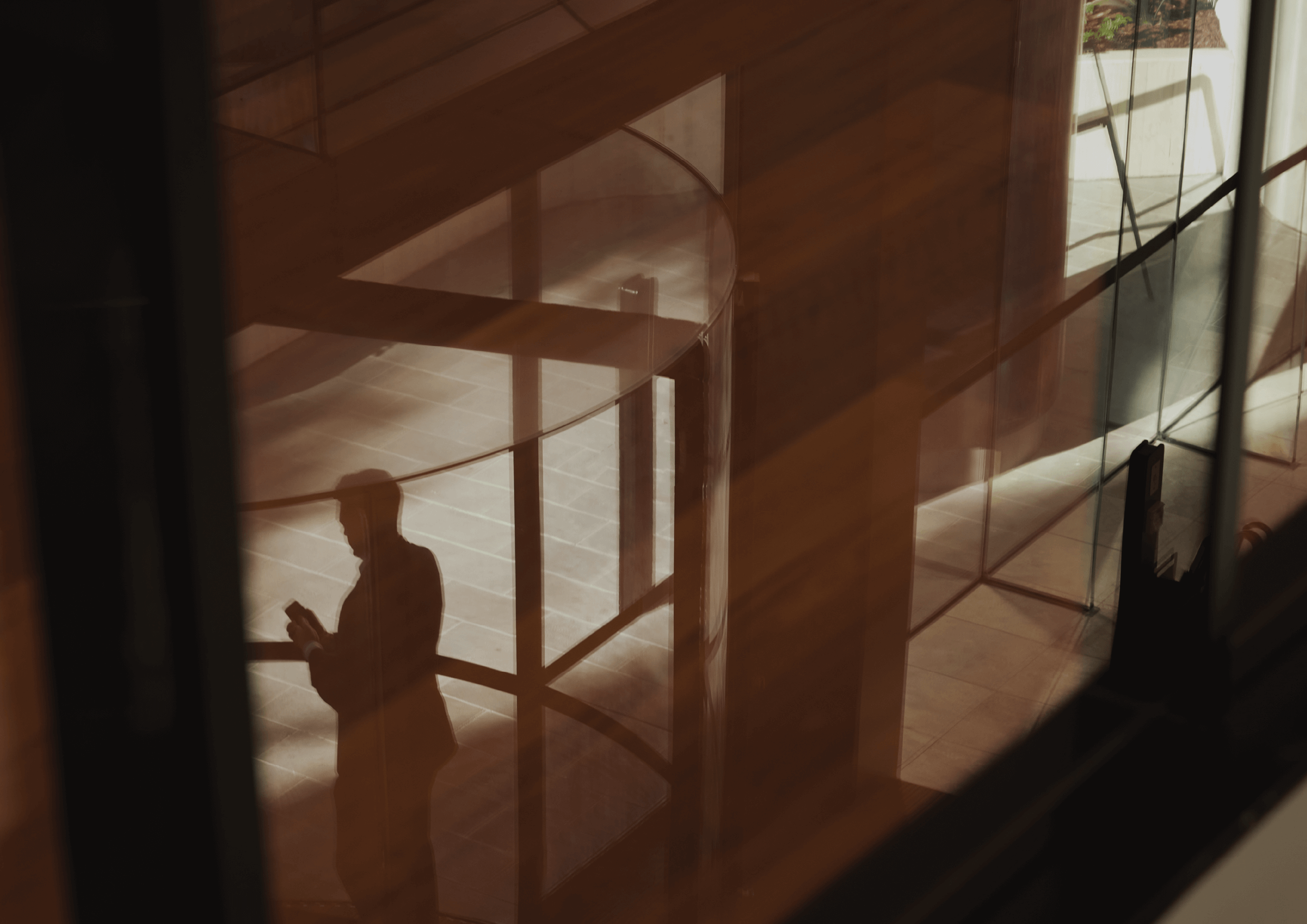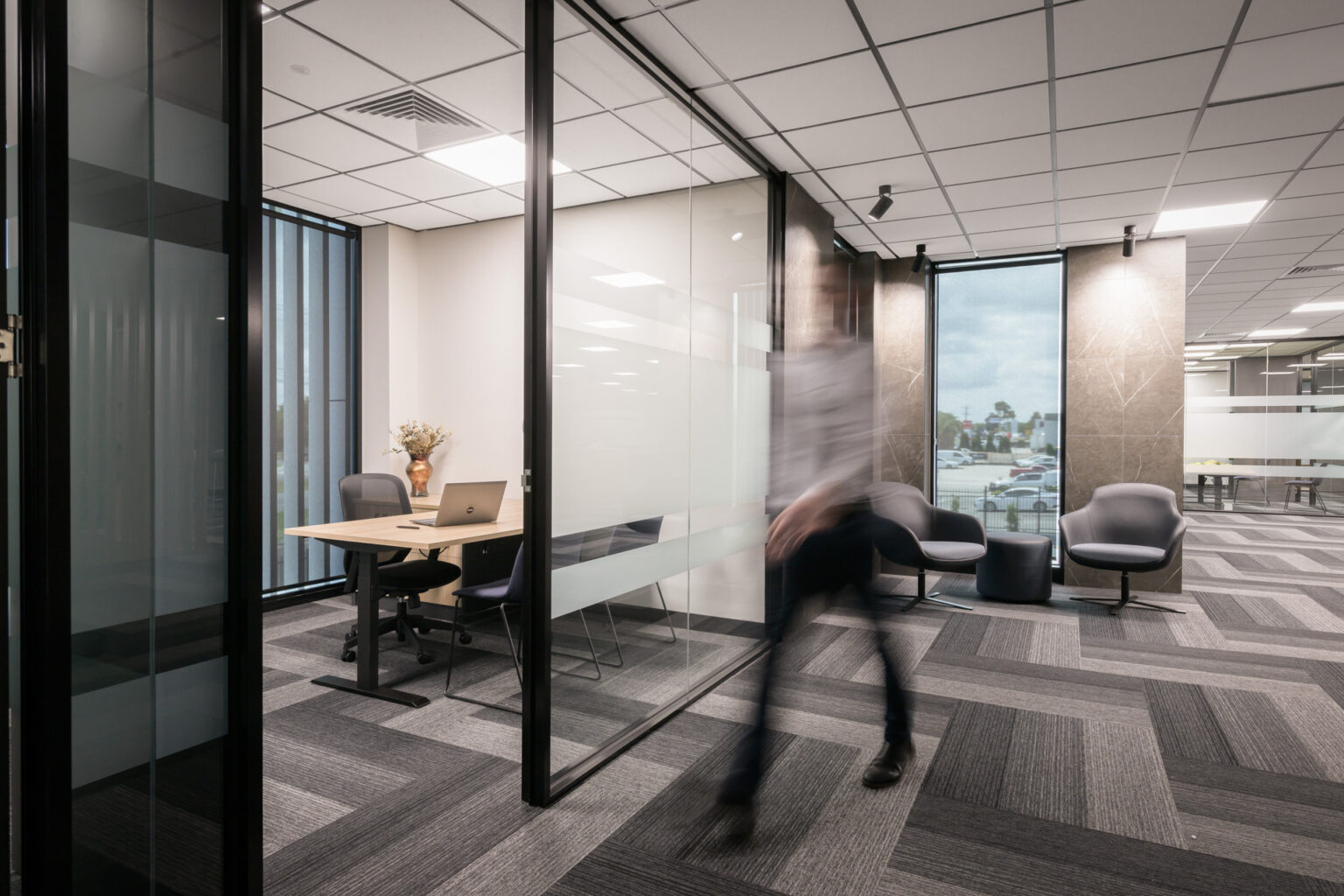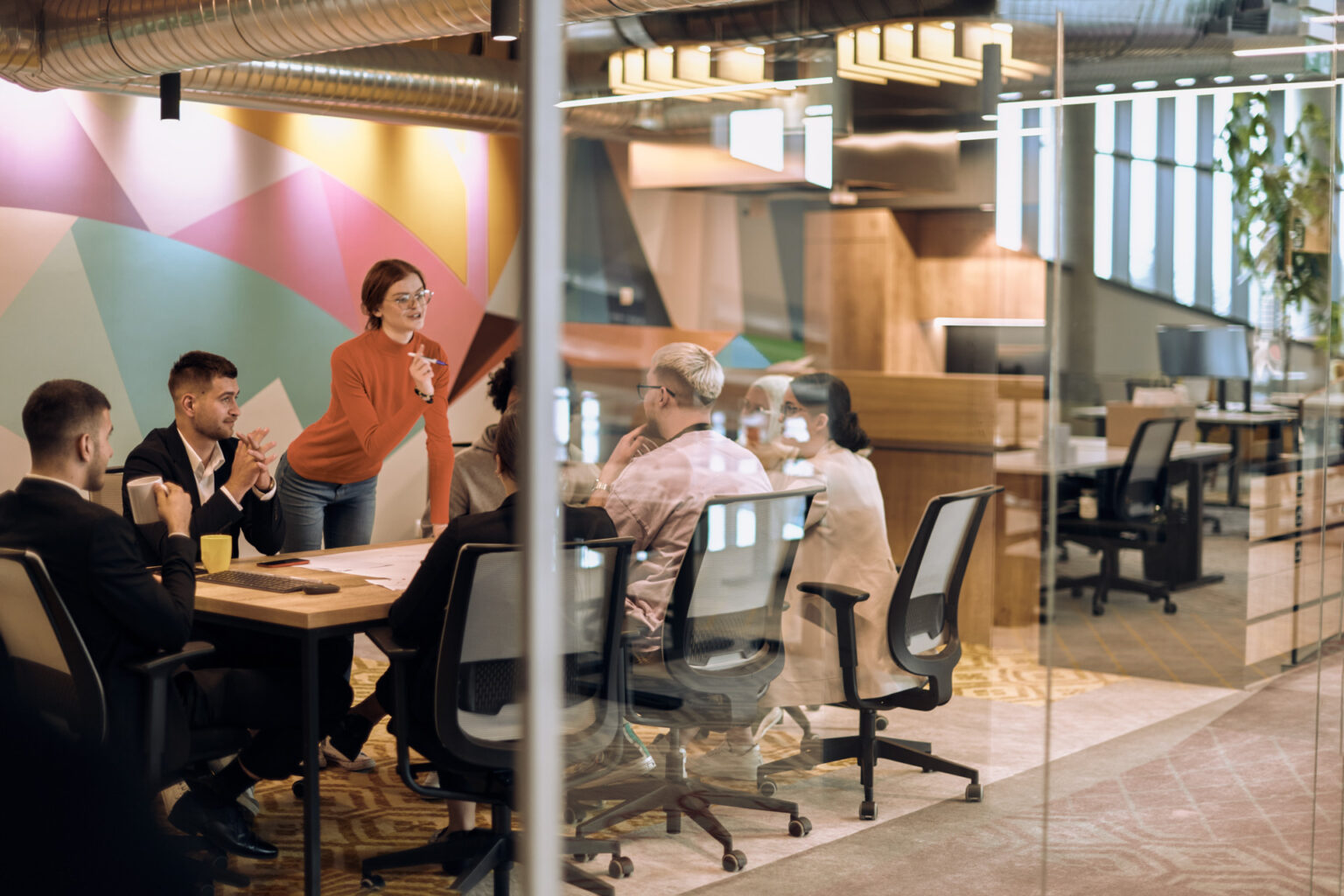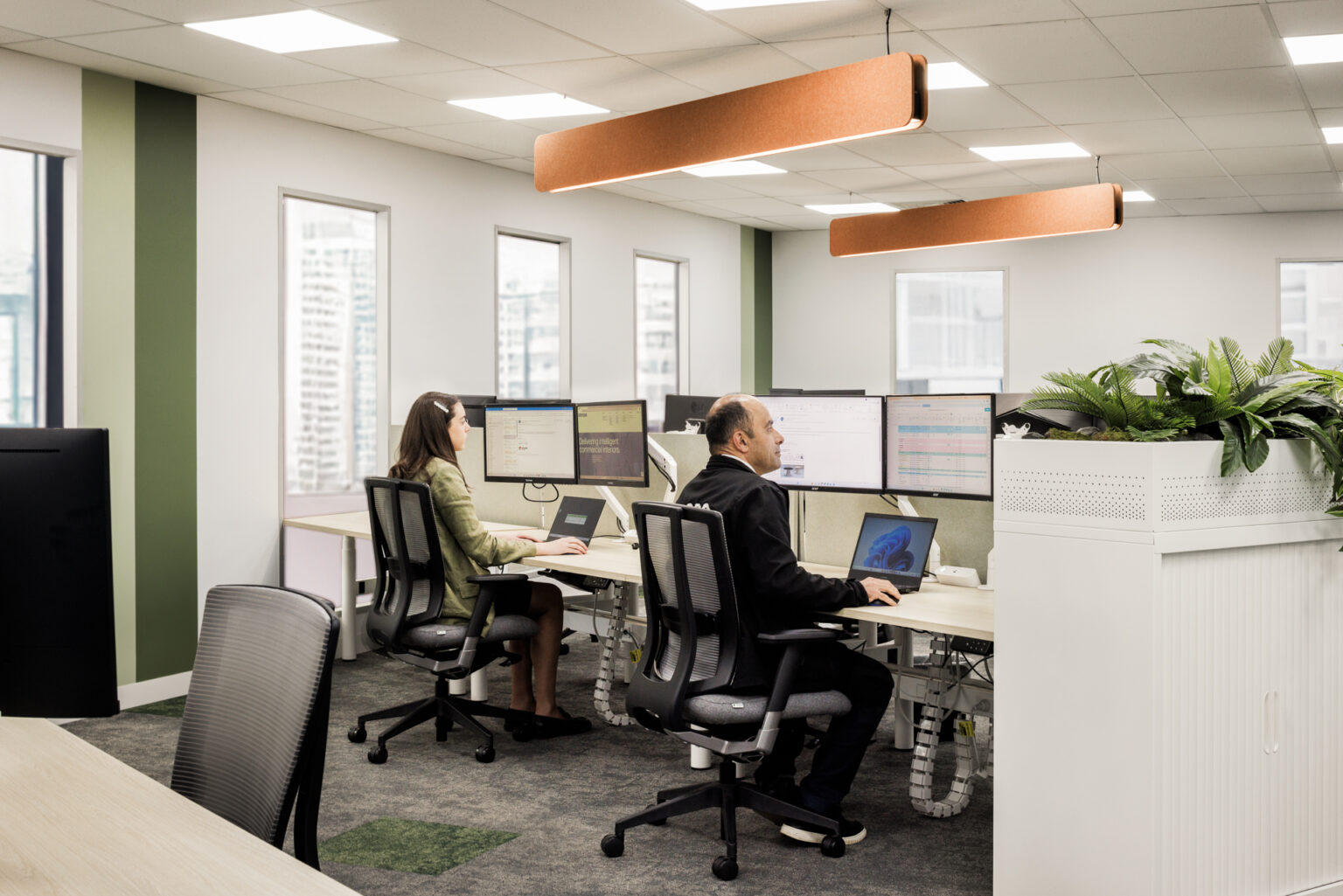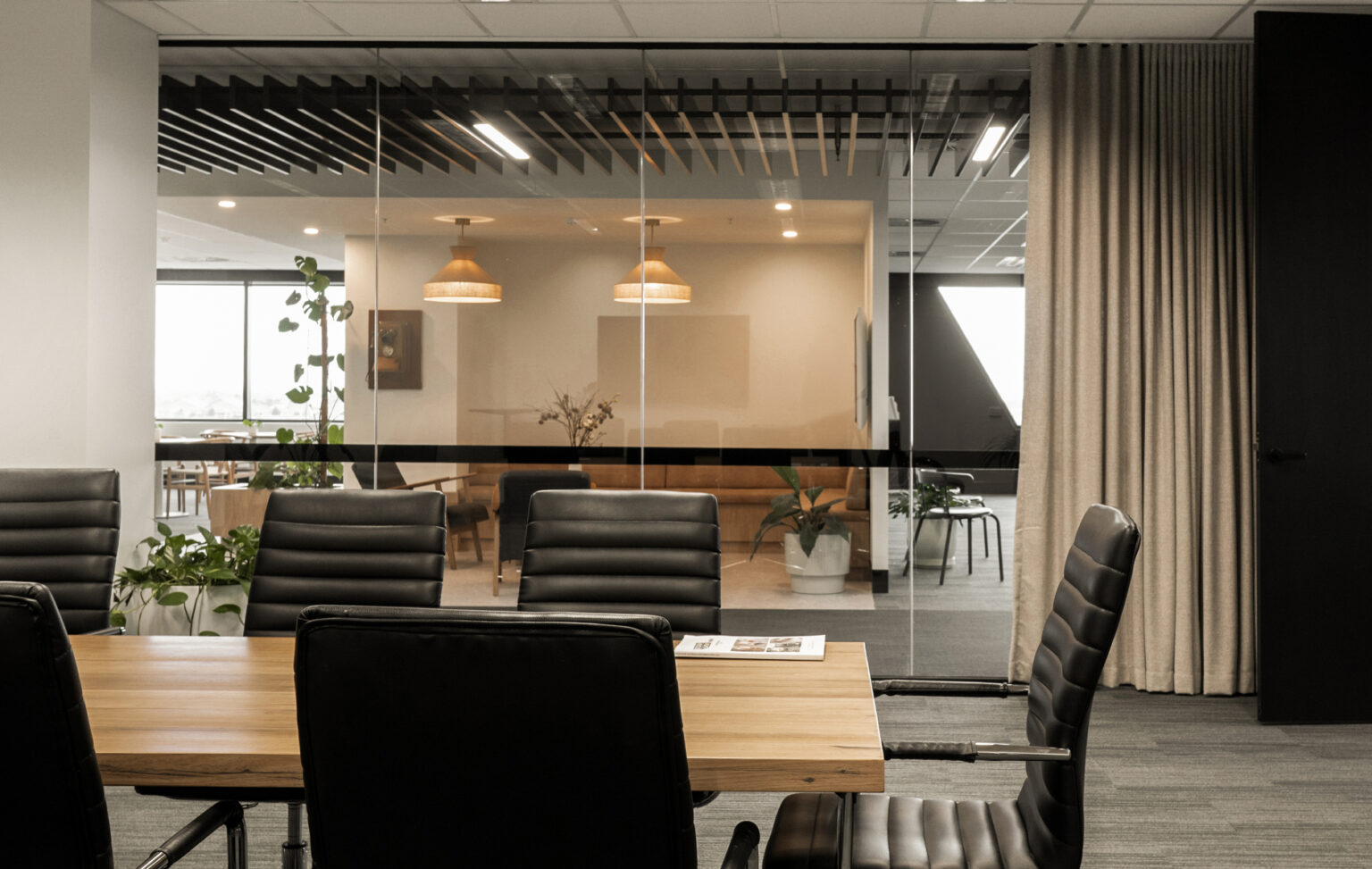Designing for well-being: how your office fitout can foster a healthy workspace.
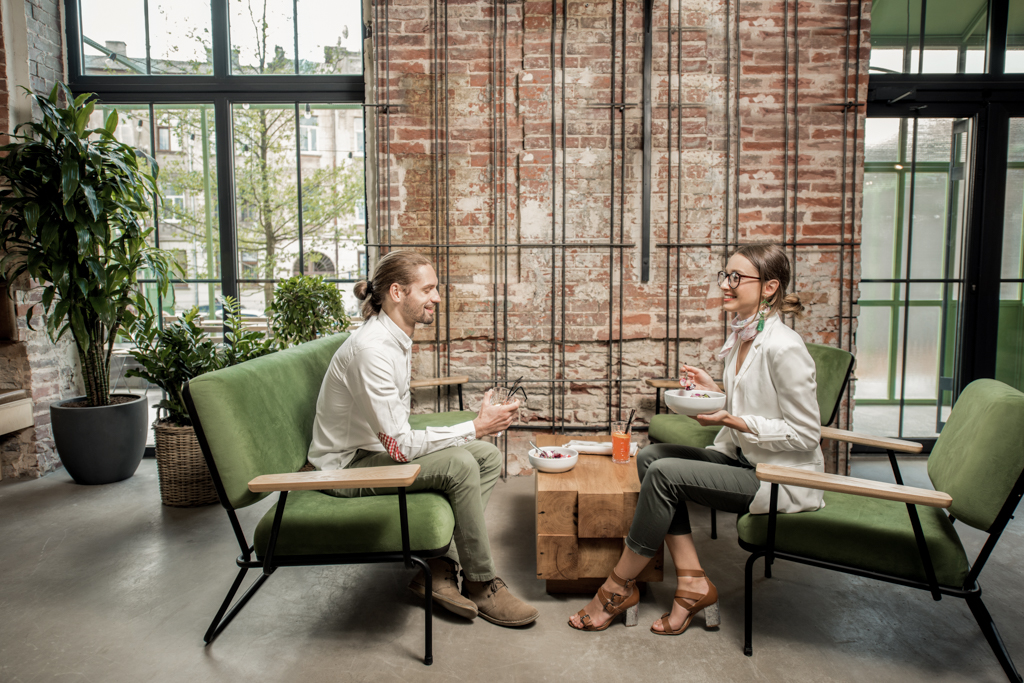
Commercial office fitouts are not just about the aesthetics – they’re also about fostering a healthy and productive workspace for employees.
The average person will spend around 90,000 hours at work over their lifetime – roughly a third of their entire life. With that being the case, isn’t it important for our work environments to be designed with our well-being in mind? After all, a healthy and happy workforce is a productive one.
While office design has traditionally been focused on functionality and ways to maximise efficiency, that no longer cuts it in today’s world. Instead, the priority has shifted towards creating workspaces that are conducive to good health and well-being.
If you’re undergoing an office fitout or renovation, continue reading to find out why it’s in your best interest to prioritise employee well-being in your new office space and how you can go about doing so.

Why Create a
Healthy Office
Space?
Isn’t it enough to have a functional workspace? Not really. Here are some of the most common benefits of a well-designed, healthy office space:
Higher Productivity
Healthy office spaces make sure that elements such as ventilation, lighting, furnishings and technology are all working together to help employees thrive. Each of these elements can have a significant impact on productivity.
For example, inadequate lighting can cause eye strain and headaches, leading to fatigue and reduced productivity. On the other hand, natural light has been shown to improve mood and alertness.
By ticking all the boxes when it comes to creating a healthy office environment, you’re setting your employees up for success and ensuring that they can work at their best.
Better Staff Retention
Did you know that a Dell study found that nearly three-quarters of employees would consider leaving their organisation if their workplace environment didn’t inspire them to fulfil their role?
This just goes to show how important the physical work environment is in retaining talent. By investing in a healthy office design, you’re showing your employees that you value them and their well-being, which can lead to higher job satisfaction and lower turnover rates.
Attract Staff
Apart from retaining current employees, a healthy office space can also help attract new talent to your company.
With the rise of wellness and work-life balance being taken more seriously in today’s workforce, potential candidates are looking for workplaces that align with their values. A well-designed, healthy office space can send the message that you care about your employees’ health and well-being, making your company a more attractive place to work.
Additionally, word-of-mouth recommendations from satisfied employees can also help attract top talent to your organisation.
More Welcoming Office for Clients
Finally, your office space can also make a significant impact on clients and visitors.
If you have a welcoming and healthy office, it can make a positive impression on clients and showcase your company’s culture. This can lead to better client relationships and even potential business opportunities.
On the other hand, if your office is cluttered, dimly lit or uncomfortable, it can give off an unprofessional vibe that may deter potential clients.
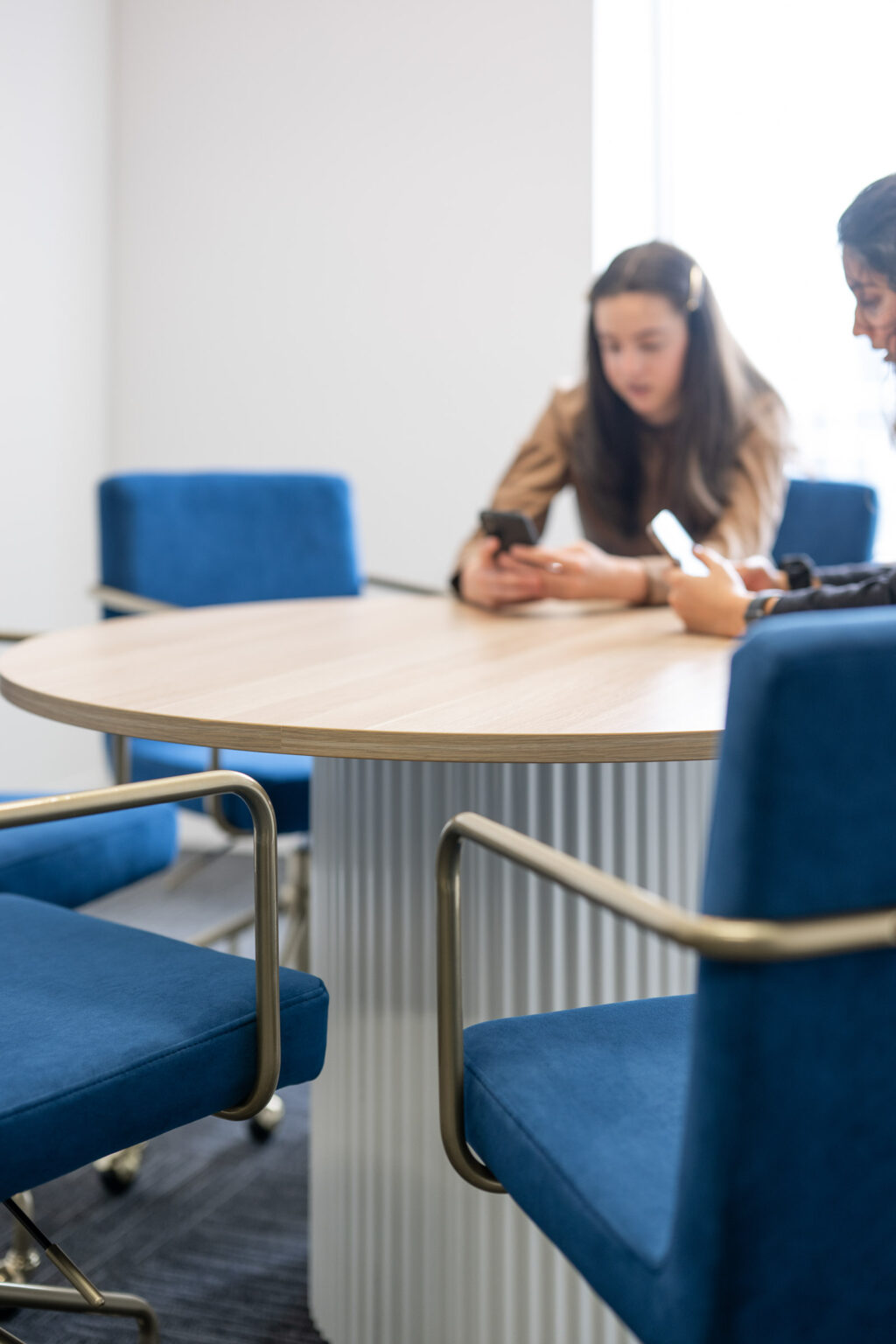
Physical elements
that create a healthy
space.
With that said, here are a range of key physical elements that will contribute to a healthy office space and working environment:
Biophilic Design
Biophilic design incorporates natural elements and patterns into the office environment to create a more connected and calming atmosphere. This can include features like indoor plants, natural lighting, and outdoor views – also known as bringing the outside in. Studies have shown that incorporating biophilic design in office settings can help reduce stress levels, improve cognitive function, and increase productivity.
This could be as simple as having potted plants on desks, incorporating natural materials such as wood and stone in the design of the office, having a dedicated outdoor space for employees to take breaks, or even using nature-inspired colours in the decor.
Defined Work and Collaboration Zones
One study found that employees lose an average of 86 minutes per day due to distractions in the workplace, the main one being irrelevant speech from co-workers. To combat this, a well-designed office also considers the different types of work that employees do and provides designated areas for each. This ensures that employees have a space suitable for their specific tasks, whether it be quiet work or collaborative discussions.
This could take the form of private offices, office partitions, open workstations, meeting rooms, dedicated project spaces and breakout areas. When employees have the right environment to work in, they’re more likely to feel comfortable and productive.
Colours
The colours used in an office can have a significant impact on employees’ mood and productivity. Bright, bold colours (like yellows and oranges) can be stimulating but also overwhelming, while soft tones (like blues and greens) can create a calming effect. It’s important to use a mix of colours that reflect the company’s brand while also considering the psychological effects they may have on employees. Colours can also be used to effectively demarcate between different zones – for instance calming colours in focus zones, or bold colours in collaborations spaces.
Ergonomic Furniture
Back pain, neck strain, and carpal tunnel are all common ailments that can result from using poorly designed office furniture. Investing in ergonomic furniture (such as adjustable chairs, standing desks, wrist support for keyboards, etc.) can greatly reduce the risk of these injuries and improve employees’ comfort levels. This not only improves physical health but also leads to increased productivity by reducing the number of breaks needed due to discomfort and days off due to injury.
And speaking of ergonomic considerations, it’s important to also design the office layout and furniture in a way that promotes good posture and movement. This means having proper spacing between workstations, providing areas for employees to stand and stretch, and encouraging them to take breaks from sitting throughout the day.
“End of Trip” Facilities to Encourage Exercise
Many companies have started to incorporate shower and change facilities in their offices to encourage employees to exercise before, during, or after work, and it’s been proven to have positive effects on productivity. Regular exercise improves mental alertness, reduces stress and fatigue, and boosts energy levels – all of which are crucial for employee performance.
Having these facilities available can also make it easier for employees to incorporate exercise into their daily routine without the added hassle of going home to shower and change before or after work. For instance, employees can go for a run during their lunch break and quickly freshen up before getting back to work.
Technology to Improve Collaboration
A lot of time can be wasted in the workplace due to inefficient communication and collaboration methods. Investing in technology that streamlines these processes, such as project management software, video conferencing tools, cloud storage, and similar, can greatly improve productivity.
These tools allow for easier communication, file sharing, and task management, allowing employees to work more efficiently and effectively as a team.
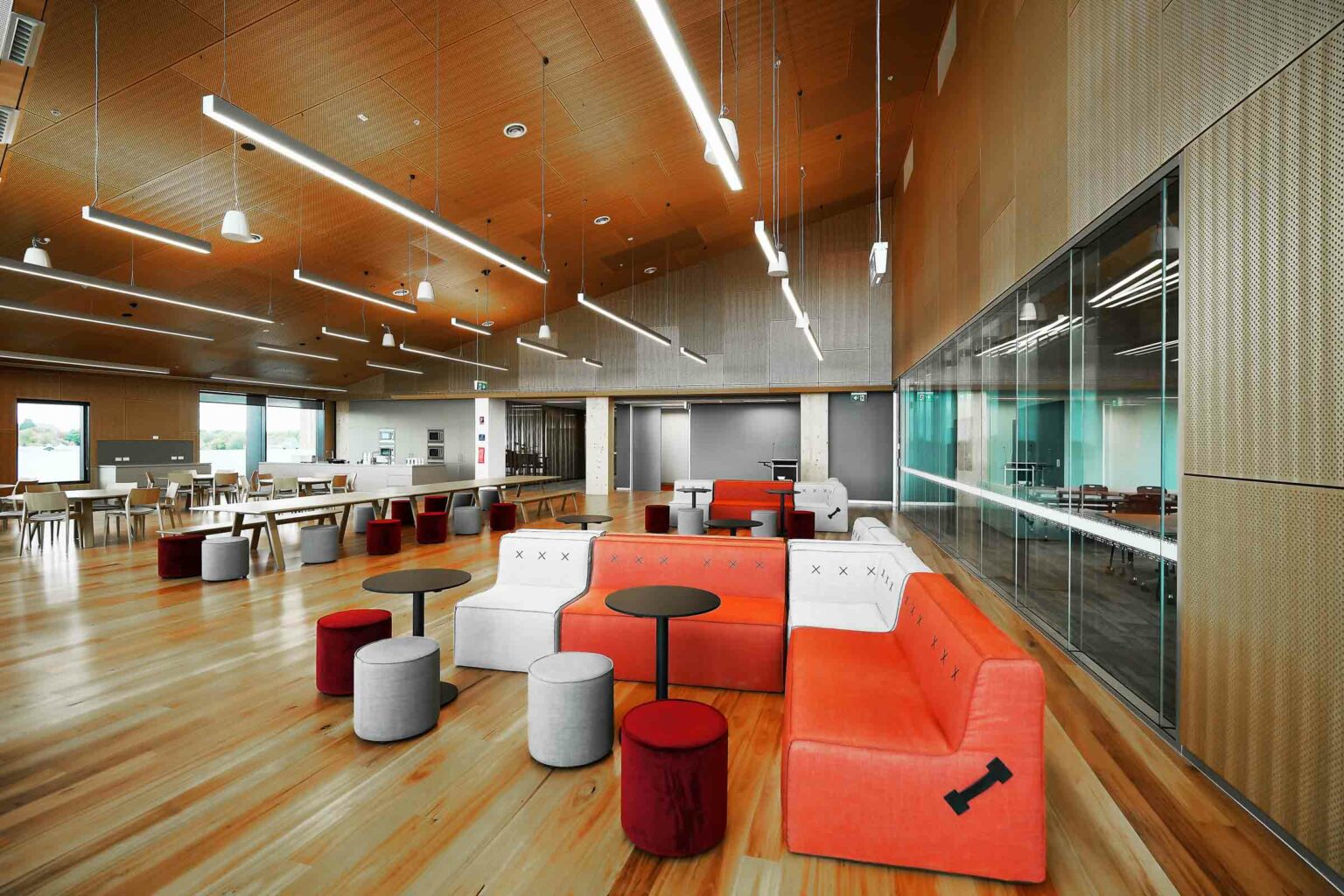
Environmental elements
to build your healthy
space.
Those were the physical aspects of a healthy workspace that you should factor in your office fitout, but there are also environmental factors, mostly non-physical, that can greatly contribute to a positive and productive work environment. These elements include:
Access to Natural Light
Natural light is one of the most important environmental factors that can greatly affect productivity in the workplace.
For instance, it has been proven that employees who sit near a window with optimized daylight exposure were 2% more productive – that’s equivalent to an additional $100,000 per year for every 100 workers or around $2 million over the lifetime of a window.
Therefore, it’s crucial to design workspaces that allow for natural light to enter and reach as many employees as possible.
Acoustic Solutions and Quiet Zones
With 75% of employees saying that excessive office noise prevents them from being productive, it’s important to consider acoustic solutions in the workplace as well as the introduction of quiet zones for focused work.
Some solutions could include sound-absorbing materials, white noise machines, or even plant walls to help reduce noise levels. As for quiet zones, these could be designated areas where employees can go to work in silence, without any distractions, like pods, phone booths, meeting rooms, or designated quiet rooms.
Good Air Quality & Proper Ventilation
Proper ventilation isn’t an option, but a necessity. Not only does it affect the health and well-being of employees, but it also plays a significant role in their productivity and performance.
One study revealed that the higher the ventilation rates, the better the performance (speed & accuracy) of employees in completing typical office tasks. This is because increased ventilation rates provide a constant flow of fresh air, reducing the buildup of carbon dioxide and other pollutants that can cause drowsiness and lack of focus.
To ensure decent air quality in your commercial space, it’s important to regularly check and maintain ventilation systems, such as air filters and ducts. Additionally, incorporating natural elements into the workplace, such as plants or a living green wall, can also improve air quality by absorbing pollutants and releasing oxygen.
Minimal Clutter
According to the Wall Street Journal, the average executive wastes six weeks per year retrieving misplaced information from messy office desks and files. This not only affects productivity but also adds unnecessary stress to employees’ daily tasks. And the problem is that most times, it isn’t that there’s no space, but rather, it’s just disorganised.
There are different ways to minimise clutter in the workplace during the office fitout process – from implementing a paperless system to providing ample storage spaces and organising workstations. Start by decluttering the office space and then create a system for organising information, whether physical or digital.
Moreover, encourage employees to regularly tidy up their workspaces and put everything back in its designated place after use. By keeping the workspace clean and organised, employees can easily find what they need without wasting time searching through piles of clutter.
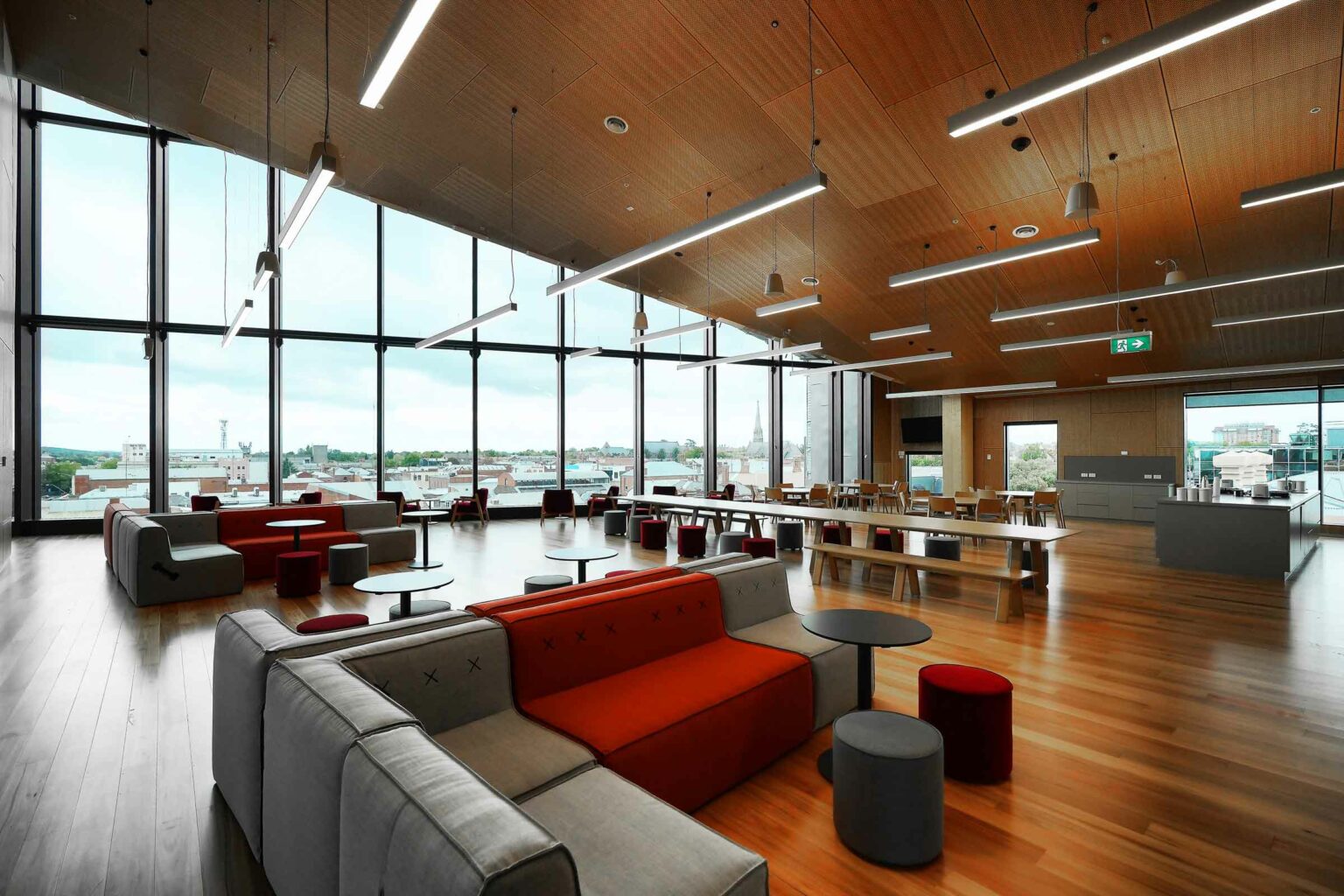
Looking to create a healthy workplace for your Melbourne office?
Small changes can make a big impact when it comes to creating a healthy workplace. It all adds up when you consider how each employee’s well-being contributes to the overall productivity and success of your business.
If your Melbourne office fitout is about to begin and a new office design is in the works, we’d love to help by offering you our office fitout services. At Sensa Interiors, our office fitout solutions are never just about the aesthetic appeal in itself– we’ve seen firsthand how a well-designed office can improve staff morale, enhance collaboration, and increase employee productivity.
Invest in creating a healthy workplace now, and reap the benefits later. A healthy workplace is a productive workplace!

